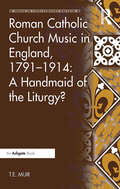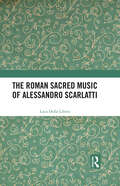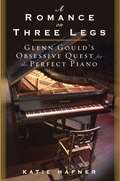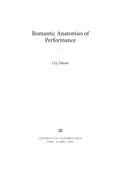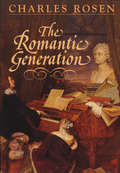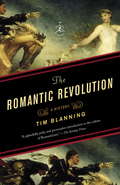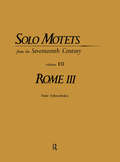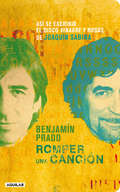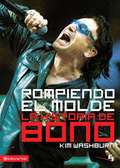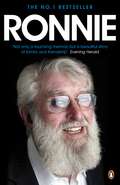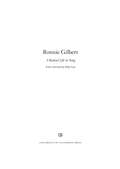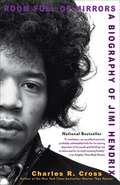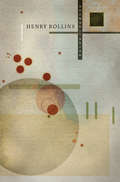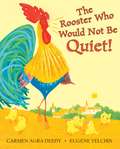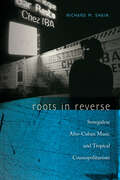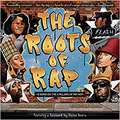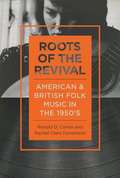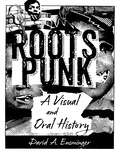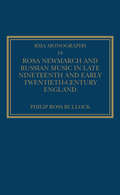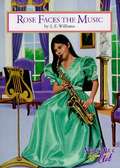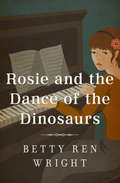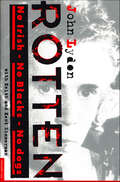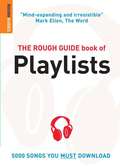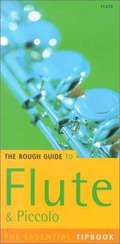- Table View
- List View
Roman Catholic Church Music in England, 1791–1914: A Handmaid of the Liturgy? (Music in Nineteenth-Century Britain)
by T.E. MuirRoman Catholic church music in England served the needs of a vigorous, vibrant and multi-faceted community that grew from about 70,000 to 1.7 million people during the long nineteenth century. Contemporary literature of all kinds abounds, along with numerous collections of sheet music, some running to hundreds, occasionally even thousands, of separate pieces, many of which have since been forgotten. Apart from compositions in the latest Classical Viennese styles and their successors, much of the music performed constituted a revival or imitation of older musical genres, especially plainchant and Renaissance Polyphony. Furthermore, many pieces that had originally been intended to be performed by professional musicians for the benefit of privileged royal, aristocratic or high ecclesiastical elites were repackaged for rendition by amateurs before largely working or lower middle class congregations, many of them Irish. However, outside Catholic circles, little attention has been paid to this subject. Consequently, the achievements and widespread popularity of many composers (such as Joseph Egbert Turner, Henry George Nixon or John Richardson) within the English Catholic community have passed largely unnoticed. Worse still, much of the evidence is rapidly disappearing, partly because it no longer seems relevant to the needs of the modern Catholic Church in England. This book provides a framework of the main aspects of Catholic church music in this period, showing how and why it developed in the way it did. Dr Muir sets the music in its historical, liturgical and legal context, pointing to the ways in which the music itself can be used as evidence to throw light on the changing character of English Catholicism. As a result the book will appeal not only to scholars and students working in the field, but also to church musicians, liturgists, historians, ecclesiastics and other interested Catholic and non-Catholic parties.
The Roman Sacred Music of Alessandro Scarlatti
by Luca Della LiberaThis book offers an account of the sacred music written by Alessandro Scarlatti (1660-1725) in Rome, a city where the composer lived and worked for many years throughout his career. Using archival research, Luca Della Libera provides an overview of Scarlatti’s life and activities in Rome, addresses his connections with the institutions and patrons of the city, and analyses his Roman repertoire in comparison to the sacred music of other contemporary composers, demonstrating its unique characteristics. An appendix includes transcriptions of the archival sources connected with Scarlatti’s activity in Rome. The first major publication in English to address the sacred music repertoire of one of the major composers of the Italian Baroque, this book offers new insights into Scarlatti’s work and a valuable resource for researchers in musicology and early modern studies.
A Romance on Three Legs: Glenn Gould's Obsessive Quest for the Perfect Piano
by Katie HafnerThe story of a legendary pianist's obsession with the unique, temperamental instrument he loved. Important figures in Gould's life are introduced including his nearly blind tuner.
Romantic Anatomies of Performance
by James Q. DaviesRomantic Anatomies of Performance is concerned with the very matter of musical expression: the hands and voices of virtuosic musicians. Rubini, Chopin, Nourrit, Liszt, Donzelli, Thalberg, Velluti, Sontag, and Malibran were prominent celebrity pianists and singers who plied their trade between London and Paris, the most dynamic musical centers of nineteenth-century Europe. In their day, performers such as these provoked an avalanche of commentary and analysis, inspiring debates over the nature of mind and body, emotion and materiality, spirituality and mechanism, artistry and skill. J. Q. Davies revisits these debates, examining how key musicians and their contemporaries made sense of extraordinary musical and physical abilities. This is a history told as much from scientific and medical writings as traditionally musicological ones. Davies describes competing notions of vocal and pianistic health, contrasts techniques of training, and explores the ways in which music acts in the cultivation of bodies..
The Romantic Generation (The\charles Eliot Norton Lectures #2018)
by Charles RosenWhat Charles Rosen’s celebrated book The Classical Style did for music of the Classical period, The Romantic Generation brilliantly does for the Romantic era. An exhilarating exploration of the musical language, forms, and styles of the Romantic period, it captures the spirit that enlivened a generation of composers and musicians, and in doing so it conveys the very sense of Romantic music. In readings uniquely informed by his performing experience, Rosen offers consistently acute and thoroughly engaging analyses of works by Schubert, Schumann, Mendelssohn, Bellini, Liszt, and Berlioz, and he presents a new view of Chopin as a master of polyphony and large-scale form. He adeptly integrates his observations on the music with reflections on the art, literature, drama, and philosophy of the time, and thus shows us the major figures of Romantic music within their intellectual and cultural context. Rosen covers a remarkably broad range of music history and considers the importance to nineteenth-century music of other cultural developments: the art of landscape, a changed approach to the sacred, the literary fragment as a Romantic art form. He sheds new light on the musical sensibilities of each composer, studies the important genres from nocturnes and songs to symphonies and operas, explains musical principles such as the relation between a musical idea and its realization in sound and the interplay between music and text, and traces the origins of musical ideas prevalent in the Romantic period. Rich with striking descriptions and telling analogies, Rosen’s overview of Romantic music is an accomplishment without parallel in the literature, a consummate performance by a master pianist and music historian.
The Romantic Overture and Musical Form from Rossini to Wagner
by Moortele Steven VandeIn this book Steven Vande Moortele offers a comprehensive account of operatic and concert overtures in continental Europe between 1815 and 1850. Discussing a broad range of works by German, French, and Italian composers, it is at once an investigation of the Romantic overture within the context of mid-nineteenth century musical culture and an analytical study that focuses on aspects of large-scale formal organization in the overture genre. While the book draws extensively upon the recent achievements of the 'new Formenlehre', it does not use the overture merely as a vehicle for a theory of romantic form, but rather takes an analytical approach that engages with individual works in their generic context.
The Romantic Revolution
by Tim BlanningFrom the preeminent historian of Europe in the eighteenth and nineteenth centuries comes a superb, concise account of a cultural upheaval that still shapes sensibilities today. Long overshadowed by the contemporaneous American, French, and Industrial revolutions, the Romantic Revolution finally receives its due in Tim Blanning's bold and brilliant work.A rebellion against the rationality of the Enlightenment, a rejection of "the Academy" in favor of public opinion, Romanticism was a profound shift in expression that altered the arts and ushered in modernity, even as it championed a return to the intuitive and the primitive. Blanning describes its beginnings in Rousseau's novel La Nouvelle Héloïse, the biggest bestseller of the eighteenth century, a work that placed the creator--and not the created--at the center of aesthetic activity and led to the virtual worship of creative geniuses by the general public. Blanning reveals the glamorizing of artistic madness and suicide in Goethe's novel The Sufferings of Young Werther and the ballet Giselle; the role of sex as a psychological force in Friedrich Schlegel's novel Lucinde; the importance of mind-altering drugs to the fictional protagonist of Confessions of an English Opium Eater and to the composer Hector Berlioz in his Symphonie fantastique; and the use of naïve, dreamlike imagery in Goya's paintings of monsters, devils, and witches.Whether it was the new notion of "sex appeal" in the fames of Paganini, Liszt, and Byron, or the celebration of accessible storytelling in the novels of Walter Scott (the most popular writer of the day), The Romantic Revolution unearths the origins of ideas now commonplace in our culture. It is the best introduction to an essential time whose influence would far outlast the mechanistic "age of the railway" that, in the mid-nineteenth century, replaced it.From the Hardcover edition.
Rome (Solo Motets from the Seventeenth Century Series)
by Anne SchnoebelenThe appearance of the solo voice in church music in 1602, in Lodovico da Viadana’s Cento concerti ecclesiastici, initiated a development that would soon parallel secular solo song. This series of Italian solo motets makes available for the first time many of these rich sources of seventeenth-century sacred music. The series spans the major part of the seventeenth century, from 1621 to 1695. It includes works by composers from major cities and provincial towns. Three composers are represented by multiple collections: Maurizio Cazzati (6); Bonifazio Graziani (6); and Isabella Leonarda (5). In each case, the solo motet forms a major component in that composer’s oeuvre; their collections provide comprehensive "textbooks" for the study of the genre.
Romper una canción: Así se escribió el disco Vinagre y rosas, de Joaquín Sabina
by Benjamín PradoUn día, a principios del año 2009, Joaquín Sabina y Benjamín Prado decidieron irse a Praga a escribir canciones y siete meses después habían acabado el disco Vinagre y rosas. Este libro cuenta esa aventura que fue puro rock and roll, llena de versos y versos tachados, chicas que vienen y que se van, viajes, música, alcohol, risas y, sobre todo, lleno de una amistad sin fronteras ni direcciones prohibidas. Y también nos deja ver los talleres de cada canción y nos hipnotiza haciéndonos mirar las vueltas que dieron todas ellas antes de quedar acabadas. Benjamín Prado rememora en Romper una canción la intensidad de aquellos meses de trabajo en los que Sabina y él pelearon a muerte por cada palabra y llegaron a lograr una combustión y una simbiosis tan profundas que hoy día ninguno de ellos sabe quién escribió qué, porque no hay una coma sin negociar en todo el disco. Así se escribió Vinagre y rosas.
Rompiendo el molde, la historia de Bono
by Kim WashburnLA HISTORIA DE UN MUCHACHO DE DUBLÍN QUE SE CONVIRTIÓ EN UNA DE LAS MAYORES ESTRELLAS DE ROCK DEL PLANETA Y NO SE CONFORMÓ CON SER SOLAMENTE UN CANTANTE Premios, fama, riquezas… ¡Bono pareciera tenerlo todo! Pero la mayor estrella de rock del mundo confiesa tener algo todavía más importante que ha guiado cada uno de sus pasos hacia el éxito: la fe en Dios. Desde su crianza en Irlanda en tiempos realmente peligrosos, hasta tocar en los mayores escenarios del mundo, las creencias de Bono lo han mantenido arraigado y enfocado en lo que verdaderamente importa. Ya sea usando su voz para cautivar a la audiencia o luchando por la justicia y la salud en África, el mundo sabe que además de cantar, Bono es un defensor de los perdidos y un héroe para los que pelean por un mundo más justo.
Ronnie
by Ronnie DrewThe late great Dubliner, Ronnie Drew, was six months into writing his biography when he was diagnosed with cancer. He had produced warm, witty and insightful material that made it clear that he was a wonderful writer as well as a great singer and storyteller. With the encouragement of his wife Deirdre and his family, he continued to think about the book and conducted a number of interviews to keep things ticking over until he was well enough to resume work on it. But sadly, much as he wanted to, Ronnie did not get to finish his story.However, with the whole-hearted co-operation of his daughter and son, Cliodhna and Phelim, it has been possible to put together Ronnie's work on his memoir along with his other writings, interviews with Cliodhna and Phelim, a wealth of photographs and other material from the family archive, and contributions from close friends, to create a book that is a wonderful portrait of, and a fitting and loving tribute to, the man Bono called 'the king of Ireland'.
Ronnie Gilbert
by Ronnie GilbertRonnie Gilbert had a long and colorful career as a singer, actor, playwright, therapist, and independent woman. Her lifelong work for political and social change was central to her role as a performer. Raised in Depression-era New York City by leftist, working-class, secular Jewish parents, Gilbert is best known as a member of the Weavers, the quartet of the 1950s and '60s that survived the blacklist and helped popularize folk music in America. Her joyous contralto and vibrant stage presence enriched the celebrated group and propelled Gilbert into a second singing career with Holly Near in the 1980s and '90s. As an actor, Gilbert explored developmental theater with Joseph Chaikin and Peter Brook and wrote and performed in ensemble and solo productions across the United States and Canada.Ronnie Gilbert brings the political, artistic, and social issues of the era alive through song lyrics and personal stories, traversing sixty years of collaborations in life and art that span the folk revival, the Cold War blacklist, primal therapy, the back-to-the-land movement, and a rich, multigenerational family story. Much more than a memoir, Ronnie Gilbert is a unique and engaging historical document for readers interested in music, theater, American politics, the women's movement, and left-wing activism.
Room Full of Mirrors: A Biography of Jimi Hendrix
by Charles R. CrossNow in paperback, the national bestselling biography of American musical icon Jimi HendrixIt has been more than thirty-five years since Jimi Hendrix died, but his music and spirit are still very much alive for his fans everywhere. Charles R. Cross vividly recounts the life of Hendrix, from his difficult childhood and adolescence in Seattle through his incredible rise to celebrity in London's swinging sixties. It is the story of an outrageous life--with legendary tales of sex, drugs, and excess--while it also reveals a man who struggled to accept his role as idol and who privately craved the kind of normal family life he never had. Using never-before-seen documents and private letters, and based on hundreds of interviews with those who knew Hendrix--many of whom had never before agreed to be interviewed--Room Full of Mirrors unlocks the vast mystery of one of music's most enduring legends.
Roomanitarian
by Henry RollinsIn Roomanitarian, popular author, actor, musician, and spoken-word artist Henry Rollins returns to the combative prose that has won him critical acclaim and a legion of devoted fans. The book is divided into three parts: The first section, "Walking the Chasm," written in the form of a poem, epitomizes Rollins's beautifully stark, hard-hitting style. The second part, "Ended," is a series of short prose pieces reminiscent of Solipsist. Finally, the biting humor and social commentary Rollins is renowned for is on full display in "To Ann Hitler with Love," a series of mock love letters to a fictional woman who bears a striking resemblance to conservative pundit Ann Coulter.
The Rooster Who Would Not Be Quiet!
by Carmen Agra Deedy Eugene YelchinLa Paz is a happy, but noisy village. A little peace and quiet would make it just right. So the villagers elect the bossy Don Pepe as their mayor. Before long, singing of any kind is outlawed. Even the tea kettle is afraid to whistle! But there is one noisy rooster who doesn't give two mangos about this mayor's silly rules. Instead, he does what roosters were born to do.
Roots in Reverse: Senegalese Afro-Cuban Music and Tropical Cosmopolitanism (Music/culture Ser.)
by Richard M. ShainRoots in Reverse explores how Latin music contributed to the formation of the négritude movement in the 1930s. Taking Senegal and Cuba as its primary research areas, this work uses oral histories, participant observation, and archival research to examine the ways Afro-Cuban music has influenced Senegalese debates about cultural and political citizenship and modernity. Shain argues that the trajectory of Afro-Cuban music in twentieth century Senegal illuminates many dimensions of that nation’s cultural history such as gender relations, generational competition and conflict, debates over cosmopolitanism and hybridity, the role of nostalgia in Senegalese national culture and diasporic identities. More than just a new form of musical enjoyment, Afro-Cuban music provided listeners with a tool for creating a public sphere free from European and North American cultural hegemony.
The Roots of Rap: 16 Bars on the 4 Pillars of Hip-hop
by Carole Weatherford<p>Explore the roots of rap in this stunning, rhyming, triple-timing picture book! <p><i>A generation voicing stories, hopes, and fears founds a hip-hop nation. Say holler if you hear.</i></p> <p>The roots of rap and the history of hip-hop have origins that precede DJ Kool Herc and Grandmaster Flash. Kids will learn about how it evolved from folktales, spirituals, and poetry, to the showmanship of James Brown, to the culture of graffiti art and break dancing that formed around the art form and gave birth to the musical artists we know today. Written in lyrical rhythm by award-winning author and poet Carole Boston Weatherford and complete with flowing, vibrant illustrations by Frank Morrison, this book beautifully illustrates how hip-hop is a language spoken the whole world 'round, it and features a foreward by Swizz Beatz, a Grammy Award winning American hip-hop rapper, DJ, and record producer.</p>
Roots of the Revival: American and British Folk Music in the 1950s (Music in American Life)
by Rachel Clare Donaldson Ronald D CohenIn Roots of the Revival: American and British Folk Music in the 1950s, Ronald D. Cohen and Rachel Clare Donaldson present a transatlantic history of folk's midcentury resurgence that juxtaposes the related but distinct revivals that took place in the United States and Great Britain. After setting the stage with the work of music collectors in the nineteenth century, the authors explore the so-called recovery of folk music practices and performers by Alan Lomax and others, including journeys to and within the British Isles that allowed artists and folk music advocates to absorb native forms and facilitate the music's transatlantic exchange. Cohen and Donaldson place the musical and cultural connections of the twin revivals within the decade's social and musical milieu and grapple with the performers' leftist political agendas and artistic challenges, including the fierce debates over "authenticity" in practice and repertoire that erupted when artists like Harry Belafonte and the Kingston Trio carried folk into the popular music mainstream. From work songs to skiffle, from the Weavers in Greenwich Village to Burl Ives on the BBC, Roots of the Revival offers a frank and wide-ranging consideration of a time, a movement, and a transformative period in American and British pop culture.
Roots Punk: A Visual and Oral History (American Made Music Series)
by David A. EnsmingerPunk rock evokes dissent and disruption, abrasive and anarchic musicality, and a host of countercultural aesthetics. Featuring original interviews and over one hundred images, Roots Punk: A Visual and Oral History by longtime music journalist and author David A. Ensminger focuses on how punk merged with roots music to create a rich style that incorporated honky-tonk, rockabilly, doo-wop, reggae, ska, jazz, folk, blues, and labor ballads. This engagement transformed the notion of punk to include a wide array of vintage source material that seems more aligned with bolo ties and Stetsons than Doc Martens and safety pins. Ensminger explores the music’s aesthetics, traits, and themes. He contextualizes, clarifies, maps, and probes roots punk’s hybrid nature as well as its diverse, queer-inclusive, and multicultural strains. By painting a broad, nuanced, and well-documented picture of the genre from its earliest incarnation, he forms a kind of people’s history of the movement. Roots Punk features original interviews with members of Minutemen, MDC, the Dicks, the Plimsouls, Tex and the Horseheads, Dils/Rank and File, X, the Flesh Eaters, Beatnigs, Alejandro Escovedo, Robert “El Vez” Lopez, Blasters, and more. Whether covering sarcastic novelty forms or sincere embraces, Ensminger reveals and revels in a punk tradition lined with blues records, acoustic ballads, country, and hillbilly romp. In a time of growing conformity, replication, and commercialization, roots punk (sometimes dubbed cow-punk) offers a tantalizing revitalization and reimagination of the American songbook.
Rosa Newmarch and Russian Music in Late Nineteenth and Early Twentieth-Century England (Royal Musical Association Monographs #18)
by PhilipRoss BullockPhilip Ross Bullock looks at the life and works of Rosa Newmarch (1857-1940), the leading authority on Russian music and culture in late nineteenth- and early twentieth-century England. Although Newmarch's work and influence are often acknowledged - most particularly by scholars of English poetry, and of the role of women in English music - the full range of her ideas and activities has yet to be studied. As an inveterate traveller, prolific author, and polyglot friend of some of Europe's leading musicians, such as Elgar, Sibelius and Jan�k, Newmarch deserves to be better appreciated. On the basis of both published and archival materials, the details of Newmarch's busy life are traced in an opening chapter, followed by an overview of English interest in Russian culture around the turn of the century, a period which saw a long-standing Russophobia (largely political and military) challenged by a more passionate and well-informed interest in the arts Three chapters then deal with the features that characterize Newmarch's engagement with Russian culture and society, and - more significantly perhaps - which she also championed in her native England; nationalism; the role of the intelligentsia; and feminism. In each case, Newmarch's interest in Russia was no mere instance of ethnographic curiosity; rather, her observations about and passion for Russia were translated into a commentary on the state of contemporary English cultural and social life. Her interest in nationalism was based on the conviction that each country deserved an art of its own. Her call for artists and intellectuals to play a vital role in the cultural and social life of the country illustrated how her Russian experiences could map onto the liberal values of Victorian England. And her feminism was linked to the idea that women could exercise roles of authority and influence in society through participation in the arts. A final chapter considers how her late interest in the music of Czechoslovakia pi
Rose Faces the Music (Magic Attic Club)
by L. E. WilliamsOn another adventure through the mirror in the magic attic, Rose finds herself chosen to play a saxophone solo in a jazz performance at the presidential inaugural celebration.
Rosie and the Dance of the Dinosaurs
by Betty Ren WrightThe big piano recital is coming up soon, and Rosie feels anything but ready—&“captures the down-to-earth rhythms of suburban life, spiced with humor&” (Kirkus Reviews). Even though Rosie has only nine fingers, she&’s always managed well. Until now. For some reason, she can&’t master the piano solo she&’s been rehearsing for the annual recital. It&’s called &“The Dance of the Dinosaurs,&” and it&’s hard! As the recital draws near, Rosie is desperate. Why does everything seem so much more difficult now? Is it because she misses her father? Since he moved to Milwaukee to take a new job, Rosie&’s been miserable, and her mother has been acting kind of strange. Or is Rosie having trouble because she&’s worried about the burglar who&’s been secretly visiting her house? Then, too, there&’s Mary Jean, the new girl in town. Not only is she rich and pretty, but she plays the piano beautifully. In the weeks before the recital, Rosie fights some hard battles. To her surprise, she discovers that having nine fingers isn&’t such a bad thing after all.
Rotten: No Irish, No Blacks, No Dogs
by John Lydon Keith Zimmerman Kent Zimmerman"I have no time for lies and fantasy, and neither should you. Enjoy or die..." --John LydonPunk has been romanticized and embalmed in various media. An English class revolt that became a worldwide fashion statement, punk's idols were the Sex Pistols, and its sneering hero was Johnny Rotten.Seventeen years later, John Lydon looks back at himself, the Sex Pistols, and the "no future" disaffection of the time. Much more than just a music book, Rotten is an oral history of punk: angry, witty, honest, poignant, crackling with energy. Malcolm McLaren, Sid Vicious, Chrissie Hynde, Billy Idol, London and England in the late 1970s, the Pistols' creation and collapse...all are here, in perhaps the best book ever written about music and youth culture, by one of its most notorious figures.
The Rough Guide Book of Playlists
by Mark EllinghamFor late-comers to the iPod revolution or owners who simply want to learn how to get more from their music player, this guide is the perfect resource.--"Metro."
The Rough Guide to Flute and Piccolo
by Hugo PinksterboerTeaches how to play flutes and piccolos, and many other things readers want to know about them.
